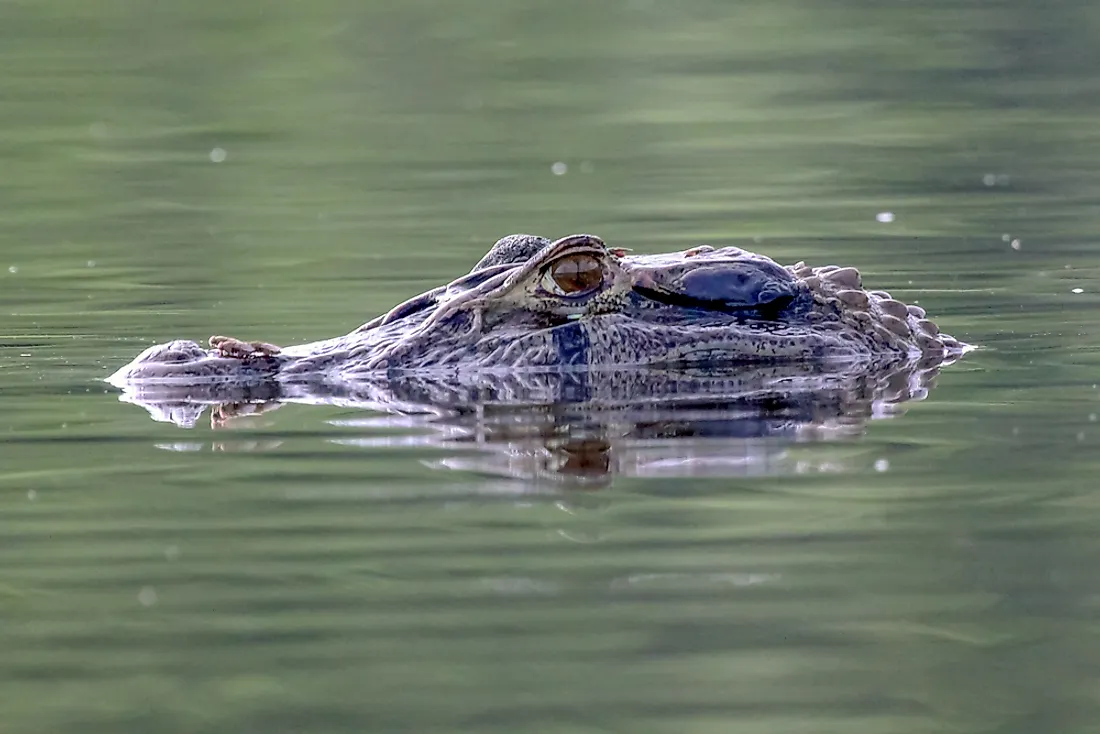What Are The Differences Between A Caiman And An Alligator?

Alligators and caiman are two creatures known for their voraciousness and ability to strike fear into any animal (including human beings) that crosses their path. The two carnivorous reptiles share many similarities; both are members of the Alligatoridae family, are cold-blooded, live in warm climates, spend their time in freshwater, and belong to the Crocodilia order. The main difference between the two animals involves the location of their native habitats. While Caimans live in the marshlands of Central America and South America, alligators can be found in only two places in the world; the Southeastern United States and eastern regions of China.
One anatomical feature that serves to differentiate the two reptiles involves the distinct characteristics of their snouts. While the alligator has a small overbite, conical teeth, and the inside of its mouth is beige in color, the caiman has a very large upper jaw with a mouth that includes many sharp, long, and narrow teeth and an interior that is orangish in hue. Caimans also have larger and higher set eyes than alligators. Another major difference between the two animals is that while alligators have single bone osteoderms (the bony deposits on their skin) caimans possess composite osteoderms.
Alligators
Alligators are usually dark grey, black, or olive brown in color with whitish undersides. They are larger than caimans with an adult weighing an average of 790 pounds and reaching a length of over thirteen feet.
There are only two species of alligator: the American alligator and the Chinese alligator. In the United States, these large reptiles can be found in a variety of southeastern states including Georgia, Florida, Texas, Louisiana, Mississippi, Alabama, North Carolina, South Carolina, Arkansas, and Oklahoma. In China, alligators are native to the Yangtze River valley and its surrounding provinces.
Alligators inhabit marshes, ponds, rivers, lakes, and swamplands. Adults consume a meaty diet consisting of turtles, fish, deer, birds, and an array of small rodents and mammals including muskrats. Alligators may also be raised in captivity with their skin used commercially in the manufacture of items such as belts, purses, shoes, and luggage. Their meat can also be consumed in various forms including as the main ingredient in dishes such as gumbo, deep-fried alligator tail, and sausages.
Caiman
Caiman are smaller in size than alligators with an average weight of thirteen to 88 pounds. The largest species of caiman, the black caiman, however, can weigh a total of 2,400 pounds with a length of sixteen feet. These reptiles are usually almost black or dull olive in color.
Caimans are native to a variety of countries in Central and South America including Mexico, Brazil, Peru, Panama, Colombia, Costa Rica, Nicaragua, Ecuador, Honduras, El Salvador, French Guiana, Guatemala, Guyana, Suriname, Venezuela, and Trinidad and Tobago. Caimans often travel in groups and are known to be more aggressive than alligators. They spend their lives in freshwater or in some cases saltwater environments such as bogs, marshes, lakes, rivers, and ponds. Their diet is made up of a wide array of water and land animals including mollusks, fish, snails, snakes, birds, and assorted mammals.
Like alligators, caimans may be kept in captivity in zoos and nature parks. Unlike their reptile relatives, however, several smaller species of these animals, in particular, the Cuvier's dwarf caiman, have become somewhat popular as exotic domestic pets.











